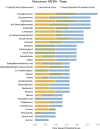A decision analysis framework for estimating the potential hazards for drinking water resources of chemicals used in hydraulic fracturing fluids
- PMID: 27666475
- PMCID: PMC5776703
- DOI: 10.1016/j.scitotenv.2016.08.167
A decision analysis framework for estimating the potential hazards for drinking water resources of chemicals used in hydraulic fracturing fluids
Abstract
Despite growing concerns over the potential for hydraulic fracturing to impact drinking water resources, there are limited data available to identify chemicals used in hydraulic fracturing fluids that may pose public health concerns. In an effort to explore these potential hazards, a multi-criteria decision analysis (MCDA) framework was employed to analyze and rank selected subsets of these chemicals by integrating data on toxicity, frequency of use, and physicochemical properties that describe transport in water. Data used in this analysis were obtained from publicly available databases compiled by the United States Environmental Protection Agency (EPA) as part of a larger study on the potential impacts of hydraulic fracturing on drinking water. Starting with nationwide hydraulic fracturing chemical usage data from EPA's analysis of the FracFocus Chemical Disclosure Registry 1.0, MCDAs were performed on chemicals that had either noncancer toxicity values (n=37) or cancer-specific toxicity values (n=10). The noncancer MCDA was then repeated for subsets of chemicals reported in three representative states (Texas, n=31; Pennsylvania, n=18; and North Dakota, n=20). Within each MCDA, chemicals received scores based on relative toxicity, relative frequency of use, and physicochemical properties (mobility in water, volatility, persistence). Results show a relative ranking of these chemicals based on hazard potential, and provide preliminary insight into chemicals that may be more likely than others to impact drinking water resources. Comparison of nationwide versus state-specific analyses indicates regional differences in the chemicals that may be of more concern to drinking water resources, although many chemicals were commonly used and received similar overall hazard rankings. Several chemicals highlighted by these MCDAs have been reported in groundwater near areas of hydraulic fracturing activity. This approach is intended as a preliminary analysis, and represents one possible method for integrating data to explore potential public health impacts.
Keywords: Exposure assessment; Hazard evaluation; Hydraulic fracturing.
Published by Elsevier B.V.
Figures







Similar articles
-
Overview of Chronic Oral Toxicity Values for Chemicals Present in Hydraulic Fracturing Fluids, Flowback, and Produced Waters.Environ Sci Technol. 2016 May 3;50(9):4788-97. doi: 10.1021/acs.est.5b04645. Epub 2016 Apr 22. Environ Sci Technol. 2016. PMID: 27050380 Review.
-
A systematic evaluation of chemicals in hydraulic-fracturing fluids and wastewater for reproductive and developmental toxicity.J Expo Sci Environ Epidemiol. 2017 Jan;27(1):90-99. doi: 10.1038/jes.2015.81. Epub 2016 Jan 6. J Expo Sci Environ Epidemiol. 2017. PMID: 26732376
-
Increases in trade secret designations in hydraulic fracturing fluids and their potential implications for environmental health and water quality.J Environ Manage. 2024 Feb;351:119611. doi: 10.1016/j.jenvman.2023.119611. Epub 2023 Dec 5. J Environ Manage. 2024. PMID: 38056330 Free PMC article.
-
Assessment of the Acute and Chronic Health Hazards of Hydraulic Fracturing Fluids.J Occup Environ Hyg. 2015;12(9):611-24. doi: 10.1080/15459624.2015.1029612. J Occup Environ Hyg. 2015. PMID: 25894916
-
Towards improved characterization of the fate and impact of hydraulic fracturing chemicals to better secure regional water quality.Environ Sci Process Impacts. 2022 Apr 21;24(4):497-503. doi: 10.1039/d2em00034b. Environ Sci Process Impacts. 2022. PMID: 35404376 Review.
Cited by
-
Association of multi-criteria derived air toxics hazard score with lung cancer incidence in a major metropolitan area.Front Public Health. 2023 Jun 26;11:1002597. doi: 10.3389/fpubh.2023.1002597. eCollection 2023. Front Public Health. 2023. PMID: 37435521 Free PMC article.
-
Environmental exposomics and lung cancer risk assessment in the Philadelphia metropolitan area using ZIP code-level hazard indices.Environ Sci Pollut Res Int. 2021 Jun;28(24):31758-31769. doi: 10.1007/s11356-021-12884-z. Epub 2021 Feb 21. Environ Sci Pollut Res Int. 2021. PMID: 33611735 Free PMC article.
-
Critical evaluation of human health risks due to hydraulic fracturing in natural gas and petroleum production.Arch Toxicol. 2020 Apr;94(4):967-1016. doi: 10.1007/s00204-020-02758-7. Epub 2020 May 9. Arch Toxicol. 2020. PMID: 32385535 Free PMC article. Review.
-
An integrative method for identification and prioritization of constituents of concern in produced water from onshore oil and gas extraction.Environ Int. 2020 Jan;134:105280. doi: 10.1016/j.envint.2019.105280. Epub 2019 Nov 6. Environ Int. 2020. PMID: 31704566 Free PMC article.
References
-
- Abualfaraj N, Gurian PL, Olson MS. Characterization of Marcellus shale flowback water. Environ. Eng. Sci. 2014;31:514–524. http://dx.doi.org/10.1089/ees.2014.0001. - DOI
-
- ATSDR. Agency for Toxic Substances and Diesease Registry (ATSDR) Glossary of terms. 2009 ( http://www.atsdr.cdc.gov/glossary.html)
-
- Barati R, Liang J-T. A review of fracturing fluid systems used for hydraulic fracturing of oil and gas wells. J. Appl. Polym. Sci. 2014;131 http://dx.doi.org/10.1002/app.40735. - DOI
-
- Brantley SL, et al. Water resource impacts during unconventional shale gas development: The Pennsylvania experience. Int. J. Coal Geol. 2014;126:140–156. http://dx.doi.org/10.1016/j.coal.2013.12.017. - DOI
-
- DiGiulio DC, Jackson RB. Impact to underground sources of drinking water and domestic wells from production well stimulation and completion practices in the Pavillion, Wyoming. Field Environ. Sci. Technol. 2016 http://dx.doi.org/10.1021/acs.est.5b04970. - DOI - PubMed
MeSH terms
Substances
Grants and funding
LinkOut - more resources
Full Text Sources
Other Literature Sources
Medical
Research Materials

